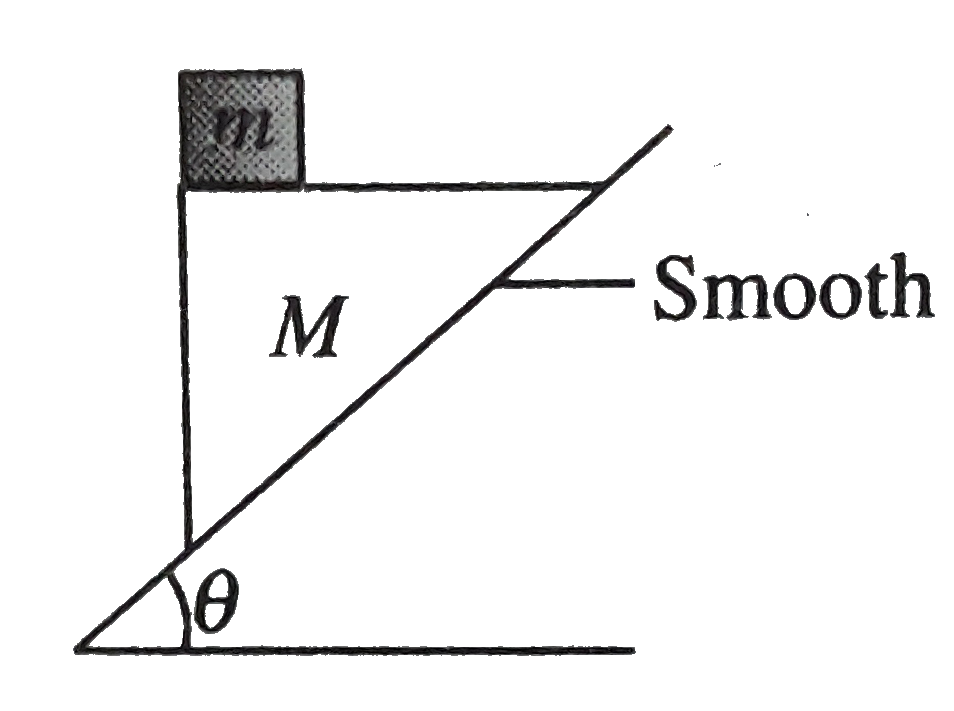A particle A having charge q and mass m is placed at the bottom of a smooth inclined plane of inclination θ. Where should a block B, having same charge and mass, be placed on the incline, so that it may remain in equilibrium?
To solve the problem of finding the position of block B on the inclined plane so that it remains in equilibrium with block A, we can follow these steps:
1. Understand the Forces Acting on Block A:
- Block A, with charge q and mass m, is placed at the bottom of the inclined plane. The forces acting on it are:
- Gravitational force mg acting downwards.
- Electrostatic force Fe acting upwards along the incline due to block B.
2. Resolve the Gravitational Force:
- The gravitational force can be resolved into two components:
- Parallel to the incline: Fparallel=mgsinθ
- Perpendicular to the incline: Fperpendicular=mgcosθ
3. Electrostatic Force Between the Two Charges:
- The electrostatic force Fe between the two charges (A and B) is given by Coulomb's law:
Fe=14πϵ0q2d2
where d is the distance between the two charges.
4. Set Up the Equilibrium Condition:
- For block A to remain in equilibrium, the electrostatic force must balance the gravitational force acting down the incline:
Fe=mgsinθ
5. Substitute the Electrostatic Force:
- Substitute the expression for Fe into the equilibrium condition:
14πϵ0q2d2=mgsinθ
6. Rearrange to Solve for d2:
- Rearranging the equation gives:
d2=q24πϵ0mgsinθ
7. Find d:
- Taking the square root of both sides, we get:
d=√q24πϵ0mgsinθ
Final Result:
The distance d at which block B should be placed on the incline to remain in equilibrium with block A is:
d=q√4πϵ0mgsinθ
- Block A, with charge q and mass m, is placed at the bottom of the inclined plane. The forces acting on it are:
- Gravitational force mg acting downwards.
- Electrostatic force Fe acting upwards along the incline due to block B.
- The gravitational force can be resolved into two components:
- Parallel to the incline: Fparallel=mgsinθ
- Perpendicular to the incline: Fperpendicular=mgcosθ
- The electrostatic force Fe between the two charges (A and B) is given by Coulomb's law:
Fe=14πϵ0q2d2
where d is the distance between the two charges.
- For block A to remain in equilibrium, the electrostatic force must balance the gravitational force acting down the incline:
Fe=mgsinθ
- Substitute the expression for Fe into the equilibrium condition:
14πϵ0q2d2=mgsinθ
- Rearranging the equation gives:
d2=q24πϵ0mgsinθ
- Taking the square root of both sides, we get:
d=√q24πϵ0mgsinθ
The distance d at which block B should be placed on the incline to remain in equilibrium with block A is:
d=q√4πϵ0mgsinθ
Topper's Solved these Questions
- ELECTROSTATICSBOOK - DC PANDEY ENGLISHCHAPTER - ELECTROSTATICSEXERCISE - Example Type 5
5 Videos
- ELECTROSTATICSBOOK - DC PANDEY ENGLISHCHAPTER - ELECTROSTATICSEXERCISE - Example Type 6
4 Videos
- ELECTROSTATIC POTENTIAL AND CAPACITORSBOOK - DC PANDEY ENGLISHCHAPTER - ELECTROSTATIC POTENTIAL AND CAPACITORSEXERCISE - (C) Chapter exercises
50 Videos
- GRAVITATIONBOOK - DC PANDEY ENGLISHCHAPTER - GRAVITATIONEXERCISE - All Questions
135 Videos
Similar Questions
A particle A having a charge of 2.0×10−6 C and a mass of 100 g is placed at the bottom of a smooth inclined plane of inclination 30∘ . Where should another particle B, having same charge and mass, be placed on the incline so that it may remain in equilibrium?
View SolutionA particle A having charge of 2.0×10−6C and a mass of 100 g is fixed at the bottom of a smooth inclined plane of inclination 30∘. Where should another particle B having same charge and mass, be placed on the inclined plane so that B may remain in equilibrium?
View SolutionA triangular prism of mass m placed on it is released from rest on a smooth inclined plane of inclination θ The block does not slip on the prism. Then

View SolutionA block of mass m is placed on a smooth inclined plane of inclination θ with the horizontal. The force exerted by the plane on the block has a magnitude
View SolutionA block of mass m is placed on a smooth inclined plane of inclination θ with the horizontal. The force exerted by the plane on the block has a magnitude
View SolutionA body is placed on a smooth inclined plane of inclination 1 in x. The horizontal acceleration to be given to the inclined plane so that the body on it remains at rest with respect to inclined plane is
View SolutionA horizontal force F is applied to a block of mass m on a smooth fixed inclined plane of inclination θ to the horizontal as shown in the figure. Resultant force on the block up the plane is:

View SolutionA solid sphere of mass m rolls without slipping on an inclined plane of inclination θ. The linear acceleration of the sphere is
View SolutionA block of mass m is kept on an inclined plane is angle inclination θ(<ϕ), where ϕ= angle of friction. Then :

View SolutionA body kept on a smooth inclined plane having inclination 1 in x will remain stationary relative to the inclined plane if the plane is given a horizontal accelertion equal to
View Solution
